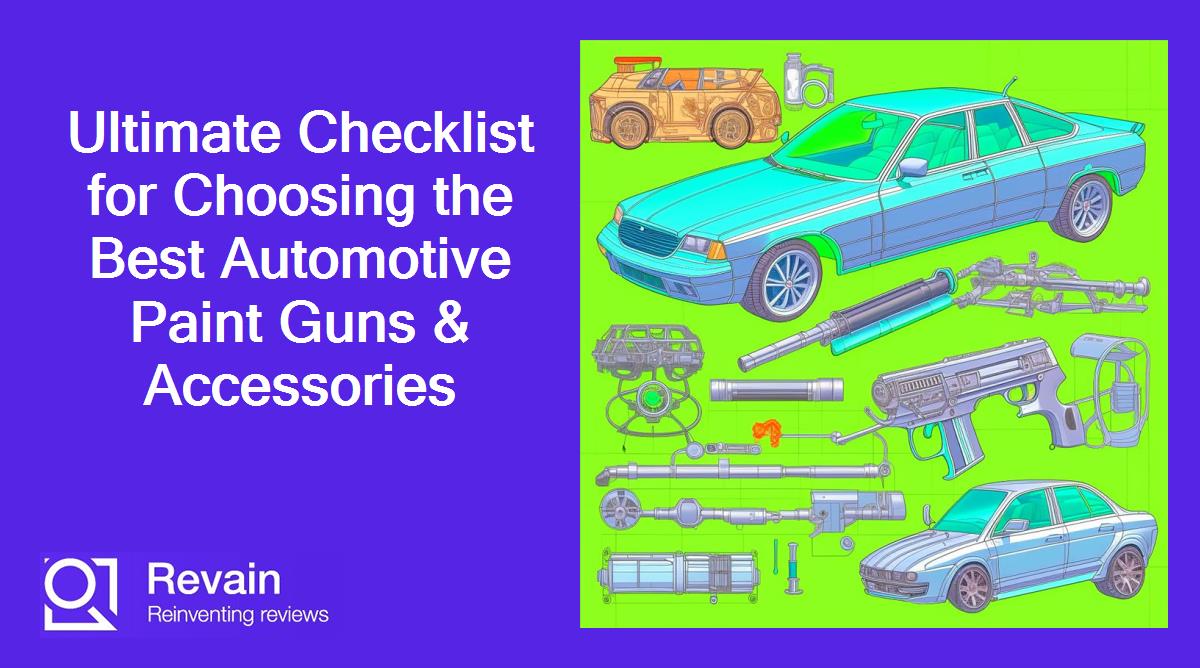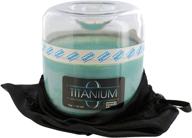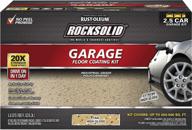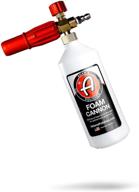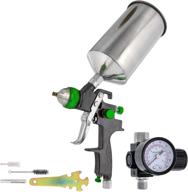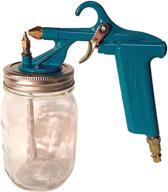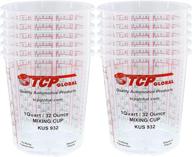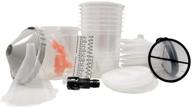Spray Guns 101: An Overview of Automotive Paint Spray Guns
Spray guns are essential tools for applying automotive paint. Selecting the right spray gun for your paint job is important to achieving a smooth, professional finish. There are three main types of spray guns used for automotive refinishing:
Gravity Feed Spray Guns
Gravity feed spray guns have the paint cup mounted on top of the gun body. Paint flows down into the nozzle using gravity. Gravity feed guns provide excellent visibility as the cup sits higher above the work surface. They also allow for consistent paint flow and are easier to clean than siphon feed guns.
Siphon Feed Spray Guns
Siphon feed spray guns have the paint cup located below the gun body. Paint is siphoned up to the nozzle by the action of compressed air flowing through the gun. Siphon feed guns hold more paint than gravity feed models. However, they can suffer paint flow issues if not held level during use.
Another interesting products
LVLP Spray Guns
LVLP (low volume, low pressure) spray guns operate at lower air pressures, typically around 10 PSI. LVLP guns apply paint more efficiently with less overspray compared to higher pressure guns. They provide superior control for applying clear coats and paints to intricate areas. However, LVLP guns have slower material application rates.
Spray Gun Features
Some key features to look for when selecting a spray gun include:
- Nozzle and tip sizes - Determined by the viscosity of paint being applied and desired spray pattern.
- Trigger style - Consider your hand size and finger length.
- Weight - Lighter aluminum guns reduce fatigue for prolonged use.
- Cup capacity - Bigger cups require less refilling but are heavier.
Top products in 🔫 Automotive Paint Guns & Accessories
Spray Gun Maintenance
Proper cleaning and care of your spray gun is essential for longevity and performance. Follow these tips:
- Clean thoroughly after each use with compatible solvents.
- Completely disassemble on a regular basis to clean internal passages.
- Lubricate moving parts and o-rings after cleaning.
- Store upright and not under pressure.
- Replace worn parts like needles and nozzle gaskets.
Investing in a quality spray gun and understanding proper operation and maintenance procedures will lead to a smooth automotive refinishing experience. Test different guns and tips to determine the best setup for your specific paint project.
Similar products
Choosing the Right Spray Gun for Your Paint Job
Selecting the appropriate spray gun is crucial for achieving the best results on your automotive paint project. The right spray gun allows you to apply paint efficiently and with less effort. Consider these factors when choosing a spray gun:
Paint Viscosity
The viscosity (thickness) of the paint material determines what size nozzle and tip you need:
- Thinner paints - 1.3 mm to 1.8 mm
- Average paints - 1.8 mm to 2.0 mm
- Thicker materials - 2.0 mm and up
Desired Spray Pattern
Fan spray patterns are measured in inches. Consider:
- Large surface areas - Wider 8-12 inch fans
- Small and confined sections - Narrow 4-6 inch fans
Feed Type
| Gravity Feed |
|
|---|---|
| Siphon Feed |
|
Air Pressure
- HVLP - 8-10 psi at the cap for minimal overspray
- LVLP - About 10 psi for superior atomization
- Conventional - 30-60 psi for applying thick coatings
Comfort and Balance
Consider the overall weight, grip, and trigger action that feels best suited to you and reduces fatigue on long jobs.
Brand Reputation
Stick with proven brands known for quality in materials, construction, and performance.
Budget
Spray gun prices range from $50 for simple siphon feed guns to $500+ for high-end LVLP models. Set a budget but don't sacrifice too much quality for cost.
Take your time researching and testing different spray guns for your particular application. Investing in the right gun will pay dividends with a smooth, flawless paint job.
Automotive Paint Gun Maintenance and Care
Taking proper care of your automotive paint gun is essential to keeping it in top working condition. Follow these gun maintenance tips and best practices:
Clean Thoroughly After Each Use
Clean the gun immediately after finishing your paint job. Leaving paint to dry in the gun will ruin it.
- Disassemble the gun completely and remove any filters or fluid tips.
- Clean all parts with gun wash or solvents compatible with the paint used.
- Use brushes and toothpicks to remove dried paint from the nozzle and fluid tip.
- Rinse all parts thoroughly and allow to fully dry.
Lubricate Moving Parts
Regular lubrication keeps parts moving smoothly.
- Use spray gun lube or lightweight oil on the trigger, fluid needle, and air valve.
- Avoid over-oiling which can cause paint flow issues.
- Wipe away excess lube and oil before reassembling.
Inspect Seals and Gaskets
Look for wear, tears, and compression issues with o-rings and gaskets. Replace damaged seals to prevent air leaks.
Replace Consumable Parts
Some parts like fluid needle tips and air caps wear down over time. Swap in new components to restore optimal spray performance.
Check for Clogs
Clogs in the paint passageways can cause uneven spray patterns. Soak clogged areas in solvent or use a fine wire to clear obstructions.
Store Properly
- Store gun upright and not under pressure to avoid seal damage.
- Place a plastic bag over the gun to keep out moisture and debris when not in use.
Service Annually
Have a qualified paint gun technician do a full service and inspection annually to keep the gun in peak condition.
Proper maintenance and care will significantly extend the lifetime of your paint gun. Always refer to the manufacturer's instructions for guidance on cleaning, lubricating, and replacing parts on your specific model.
A Beginner's Guide to Automotive Painting
Painting a car yourself can save money over a professional paint job if you're willing to take the time to do it right. Follow this beginner’s automotive painting process for best results:
Prepare the Surface
Start with a clean, dry surface free of wax, grease and other contaminants:
- Wash and degrease the car thoroughly
- Sand the existing paint to rough up the surface
- Apply body filler to smooth dents and imperfections
- Sand body filler once hardened and then clean again
Mask Off Areas
Cover any areas you don’t want painted such as windows, lights and chrome trim. Use painter’s tape and plastic sheeting.
Prime and Seal
Apply primer to provide an even base:
- Spray 1-2 coats of primer waiting 5 minutes between coats
- Sand primer smoothly and wipe clean
- Spray seam sealer for gap filling then sand again
Spray the Paint
- Apply 2-3 medium wet coats waiting 10 minutes between coats
- Spray thin even passes overlapping each stroke
- Allow the paint to flash off between coats
Clear Coat
Clear coat adds glossiness and protection:
- Apply 2-3 coats of clear coat following the paint directions
- Sand out any dust particles and imperfections
- Finish with a final clear coat layer
Remove Masking
Carefully remove all masking materials after paint has fully cured.
Tips for Beginners
- Use high quality primer, paint and clear coat
- Maintain a clean spray area and follow safety precautions
- Practice spray technique on scrap panels before painting
- Work in a well ventilated area and wear a respirator
- Take your time - proper preparation is key
Patience and attention to detail will pay off with a professional looking DIY automotive paint job.
Upgrading Your Paint Gun: Nozzle, Tip, and Air Cap Options
Upgrading components like the nozzle, tip, and air cap on your paint gun allows you to optimize performance. Here's an overview of the most common options:
Nozzle Sizes
The nozzle opening affects air pressure and paint volume delivery.
- Larger nozzle = more paint flow
- Smaller nozzle = finer atomization
Typical nozzle sizes:
- 1.2-1.4 mm - Basecoats and blending clearcoats
- 1.3-1.8 mm - Primers and single stage paints
- 1.8-2.5 mm - Surfacers, primers, and thicker coatings
Fluid Tip Sizes
The fluid tip controls the paint flow and fan pattern width. Sizes include:
- 1.3-1.4 mm - Spot repairs and fine detail work
- 1.6-1.8 mm - General automotive painting
- 2.0 mm and up - Broad spray patterns for large surfaces
Air Caps
The air cap atomizes paint into a uniform spray pattern. Types include:
- Gravity feed - Optimized fan shapes
- HVLP - High transfer efficiency
- LVLP - Superior atomization
- Trans-tech - Low overspray, high flow
Material Compatibility
Ensure replacement nozzle, tip, and air cap parts are designed for the paint material you are spraying such as:
- Clear coats
- Primers and sealers
- Single stage and basecoat paints
- 2K urethane coatings
Consult your paint gun manufacturer's recommendations and use only genuine OEM parts for optimal compatibility and performance.
Specialty Nozzle Sets
Some brands offer nozzle and tip sets designed for specific painting scenarios like spot repairs, large surfaces, fine detailing, and high viscosity materials.
Upgrading with the right components can fine tune your paint gun for the highest efficiency and finish quality on your automotive paint projects.
Must-Have Automotive Paint Gun Accessories
Having the right accessories for your paint gun makes a difference in your efficiency and finish quality. Here are some must-have add-ons:
Cleaning Kit
A cleaning kit contains necessary tools for proper paint gun maintenance:
- Brushes - Nylon and brass bristle for scrubbing
- Cleaning needles - Removes dried paint from the nozzle
- Lens cloth - Wipes down air caps
Moisture Filter
A moisture filter installed on your compressor prevents water in the airline from blowing into your paint. This avoids finish imperfections from moisture contamination.
Paint Filters
Filters for your paint cup trap debris and particles to prevent clogs and blemishes in the finish. Reusable nylon or disposable paper filters are available.
Spray Gun Lube
Light lubricating oils keep internal gun parts moving freely. A few drops on the trigger, needle, and air valve prevents sticking and binding.
Wrenches
A set of wrenches allows you to remove the nozzle, fluid tip, and air cap for cleaning. Having the right wrenches avoids stripping or damaging components.
Tip Gauge
A tip or nozzle gauge allows you to accurately measure openings for replacing worn parts or changing sizes.
Regulator
An inline air regulator lets you precisely control pressure to the gun. Lower pressure improves atomization and reduces overspray.
Cups
Extra paint cups in various sizes for quick color changes. Best to have dedicated cups for each paint color.
Investing in the right accessories makes spray gun maintenance easier and helps achieve a flawless professional-quality paint job.
DIY Automotive Paint Jobs: Tips and Recommendations
Painting your own car can save money over a professional paint shop if you follow some important guidelines for success:
Proper Surface Prep
Taking the time to properly prepare the surface is crucial for good paint adhesion:
- Thoroughly clean and degrease the entire area to be painted
- Sand and scuff the existing finish to rough up the surface
- Apply body filler to any dents and imperfections, then sand smooth
- Wipe down again with a tack cloth before painting
Clean Spray Environment
Paint particles floating around will show up as flaws in the fresh paint film. Paint in an enclosed dust-free area like a garage.
Follow Product Instructions
Closely follow the usage directions for primers, paints, clear coats to get the proper film build and curing.
Spraying Technique
Use even passes at a consistent distance overlapping each stroke. Keep the spray gun perpendicular to the surface.
Allow Proper Flash Times
Rushing paint layers can lead to runs, sags, and texture issues. Allow proper flash off time between coats.
High Quality Paint Products
Invest in premium automotive refinishing paints and clearcoats for the best results rather than budget economy grades.
Compatibility is Key
Ensure primer, paint, and clearcoat products are designed to be used together for proper bonding between layers.
Professionally Tint Paint
Have your paint color professionally mixed and tinted even for a DIY job to ensure color accuracy.
With care and patience, you can achieve professional looking results painting your own vehicle. Allow extra time and focus on proper preparation for success.
What Are The Different Types Of Spray Guns Available For Automotive Painting?
There are several types of spray guns available for automotive painting, including:
- Siphon feed spray guns: These are traditional paint guns that use a siphon to draw paint from a container and mix it with air to create a spray pattern.
- Gravity feed spray guns: These guns use gravity to feed paint into the gun, which allows for a more efficient use of paint and a better finish.
- High-volume, low-pressure (HVLP) spray guns: These guns use a high volume of air at a low pressure to atomize the paint, which results in less overspray and a smoother finish.
- Airless spray guns: These guns use high pressure to atomize the paint, which allows for a faster application and a thicker coat of paint.
- Pneumatic spray guns: These guns are powered by compressed air and are commonly used in professional auto body shops.
- Electric spray guns: These guns are powered by electricity and are a good option for DIYers or those who need a more portable option.
What Are The Advantages And Disadvantages Of Airless Spray Guns For Automotive Painting?
Airless spray guns are a popular choice for automotive painting, but they do have both advantages and disadvantages. Here are some of the pros and cons of using airless spray guns for automotive painting:
Advantages:
Disadvantages:
Overall, airless spray guns can be a good choice for automotive painting, but they may not be the best option for every project. It's important to consider the specific needs of your project and choose the spray gun that will work best for you.






